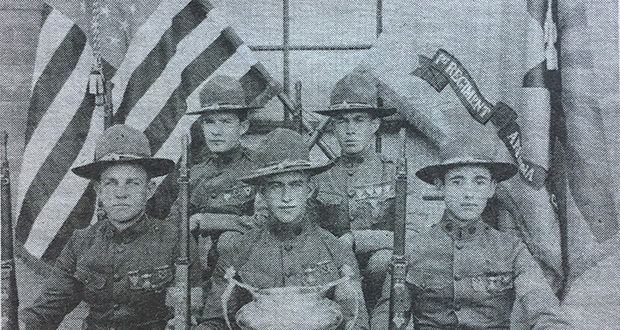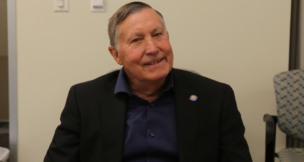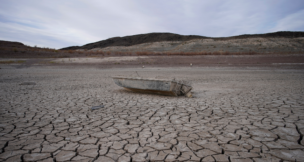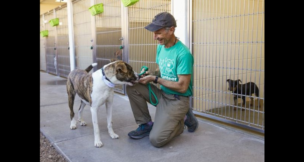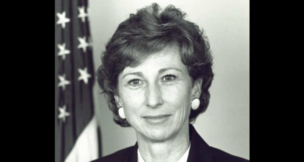The Hohokam’s Legacy: Pueblo Grande
Arizona Capitol Reports Staff//December 28, 2007//[read_meter]

Odd Halseth, Phoenix’s first city archaeologist and Pueblo Grande’s first museum director, gives a presentation to a Creighton School eighth-grade history class in 1939 with the original museum and platform mound in the background.
On the north side of the Salt River near the Papago Buttes in Phoenix are the ruins of an ancient culture known as the Hohokam. For 1,500 years, this society of desert farmers occupied the area developing complex irrigation systems and adobe structures, crafting ornate jewelry and creating a trade network with other prehistoric cultures of the Southwest. For reasons still unknown, their culture collapsed in the 15th century, shortly after Columbus arrived in the New World.
Five-hundred years later, Hohokam ruins began being explored and excavated by archeologists near present day Washington and 44th Street. Omar Turney, a city engineer who had spent many years studying the Hohokam irrigation system, named the area Pueblo Grande (Spanish for large town). The name referred to the site’s prominent platform mound, which was one of the largest structures built by the Hohokam.
Thomas Armstrong, former president of the Arizona Archaeological and Historical Society, purchased the Pueblo Grande platform mound and surrounding 3 acres in 1924 and donated the property to the city of Phoenix. The same year, Turney convinced the city to purchase an area south of the platform mound known as “Park of Four Waters.” This land contained the preserved remains of major irrigation canals that supplied water to most Hohokam villages on the north side of the Salt River.
The city wanted to develop the Hohokam site into a museum and archaeological park, so in 1929 they hired Odd Halseth as city archaeologist (the first one in the nation). Halseth’s vision for Pueblo Grande included building an outdoor museum next to the platform mound, and an archaeological laboratory with exhibits and ongoing archaeological investigations, all surrounded by a park and botanical gardens. His designs for the museum were to “incorporate professional archaeological investigations of the site, coupled with education programs for schools and visitors.”
Beginning in 1933, Halseth started construction of a pueblo-style museum next to the platform mound. With help from volunteers, he was able to build the museum out of salvaged building materials and adobe blocks made from the backdirt left from excavations. The museum was completed two years later for a total cost of $14.95 (all of it spent on nails).
Halseth’s next move was to obtain exhibit materials and information for the new museum, and he did this by using federal work programs to fund excavations. From 1934 to 1940, archaeology was conducted under the sponsorship of the Public Works Administration, the Civilian Conservation Corps and the Works Progress Administration.
Julian Hayden, Albert Schroeder and Paul Ezell — individuals who later became well known for their contributions to Southwestern archaeology — supervised the excavations. The results, known as “Relief Archaeology”, produced thousands of artifacts used in museum exhibits and exposed portions of the platform mound, which would be developed into an outdoor exhibit. It also generated hundreds of boxes of field notes and sketches, analysis sheets and photographs.
The information gained from those excavations was never fully analyzed and little was published about Pueblo Grande. Halseth considered the museum’s public programs more important than the scientific research. He wanted to focus his limited city resources on the development and promotion of Pueblo Grande as a museum.
After Halseth’s retirement in 1960, Donald Hiser took over as city archaeologist and museum director, and four years later, Pueblo Grande was declared a National Historic Landmark. Hiser wanted to further develop the museum and park, so he expanded the park’s boundaries by nearly 75 acres and in 1974 replaced the old museum building with a new facility.
In 1984, David Doyel became the museum’s third director and new city archaeologist. He continued to emphasize the museum’s public programs but also began promoting the publication of archaeological research. He initiated a major study in 1989 of the archaeological records on file in the Pueblo Grande Museum, and the Arizona Department of Transportation began an excavation of the eastern portion of the Pueblo Grande site, which is located within the Hohokam Expressway corridor (State Route 143). The excavation was the largest ever conducted in the Southwest and recovered more than 1,500 archaeological artifacts and a wealth of data.
Doyel resigned in 1990, and the city decided to create separate positions for museum director and city archaeologist. Roger Lidman became the museum’s new director and Todd Bostwick became the new city archaeologist. Since 1995, the museum has added two more buildings, a community room and permanent collection storage, doubling the size of the complex. Today, Pueblo Grande offers outdoor exhibits of Hohokam houses and artifacts along a 2/3-mile interpretive trail and an indoor gallery featuring exhibits on a variety of topics.
— Research by Tracy Keller. Photo courtesy Pueblo Grande Museum.










